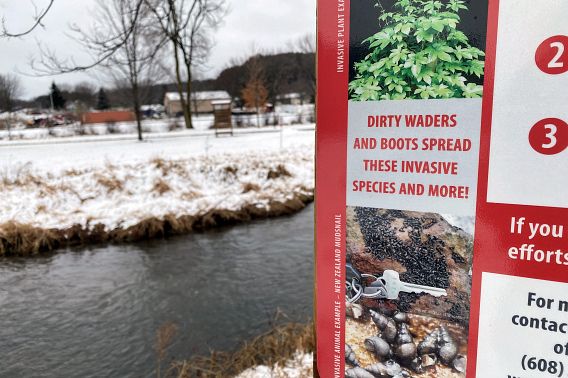Contact: Jeanne Scherer, Aquatic Invasive Species Outreach Specialist
Jeanne.Scherer@wisc.edu or 608-720-0195
Help Protect Our Streams From Aquatic Invasive Species

MADISON, Wis. – The Wisconsin Department of Natural Resources (DNR) reminds anglers out for the early inland trout season to help protect our streams from aquatic invasive species. Some fishing streams may contain invasive species, and if care is not taken, those species can accidentally be transferred to another.
New Zealand mudsnails have one of the highest potentials of spreading from one water to another. Only 4-6 millimeters in length, they can easily get stuck in the mud and picked up on boots, waders and gear. Felt-soled boots are particularly susceptible to these snails as they can lodge into and under the felt. The snails can live in the mud along the shore, so they can be spread without ever stepping foot into the water.
Some seeds and fragments of invasive plants can survive throughout winter under the ice. Thoroughly cleaning fishing gear before leaving a fishing site can help stop the chance of spreading invasive species.
Cold Wisconsin winters usually help combat the spread of invasives. The DNR encourages anglers to leave fishing gear where it can freeze for 8 hours or more as this will kill most species, including New Zealand mudsnails. Other methods to kill aquatic invasive species hiding in fishing gear are to steam clean the gear or to soak it in either 140° water or 2% Virkon solution (5.4 tablespoons per gallon) for 20 minutes. Many people aware of the risks will also switch to a new set of gear for a second adventure, especially if they have been fishing in a stream known to have mudsnails.
A few minutes of preventative action can help preserve and protect waterways for generations to come. Before leaving a fishing site, anglers should:
- Inspect fishing equipment for attached aquatic plants, animals or mud.
- Remove all attached plants or animals.
- Drain all water from buckets and containers.
- Never move live fish away from a waterbody (fish out of water = dead).
To learn more about invasive species and their impacts on Wisconsin's waters, visit the DNR's Aquatic Invasive Species webpage.

